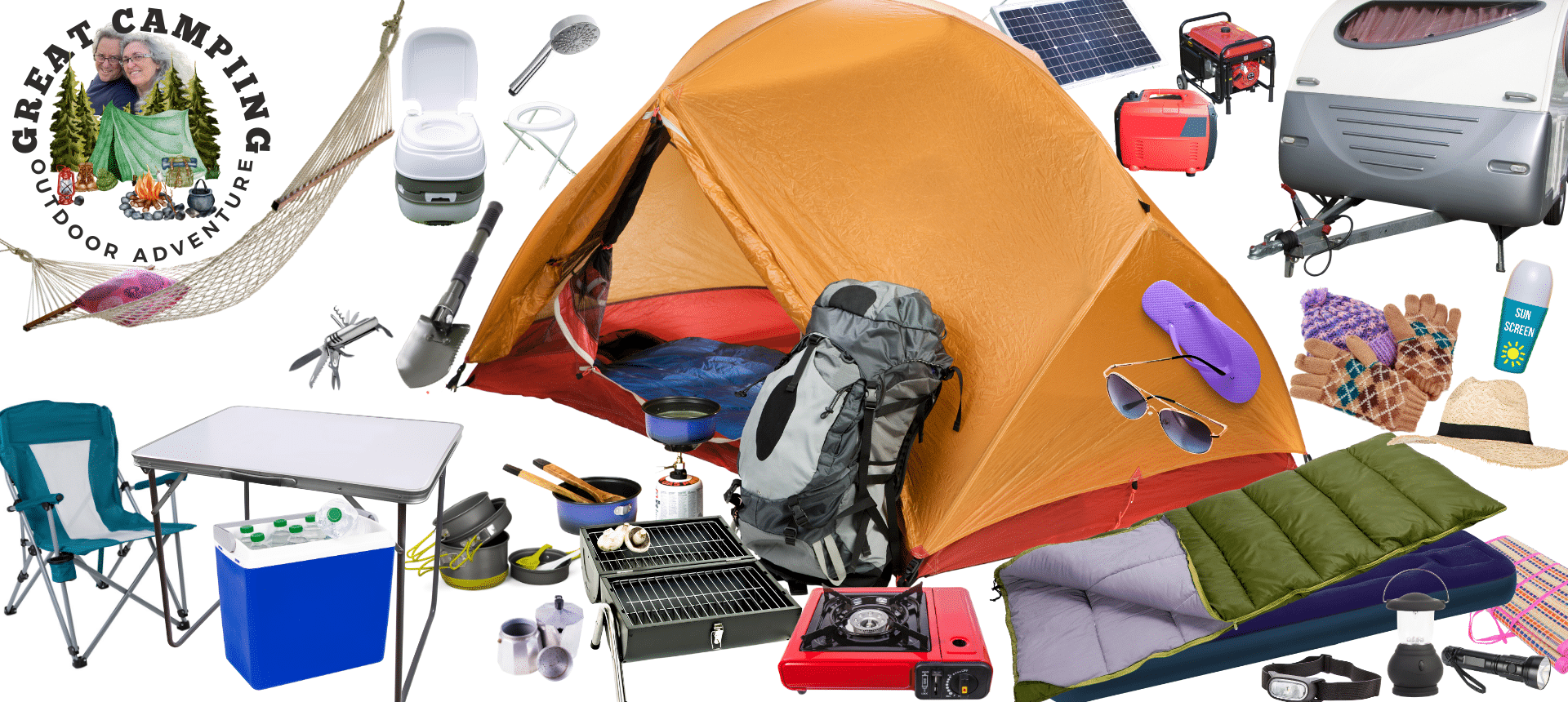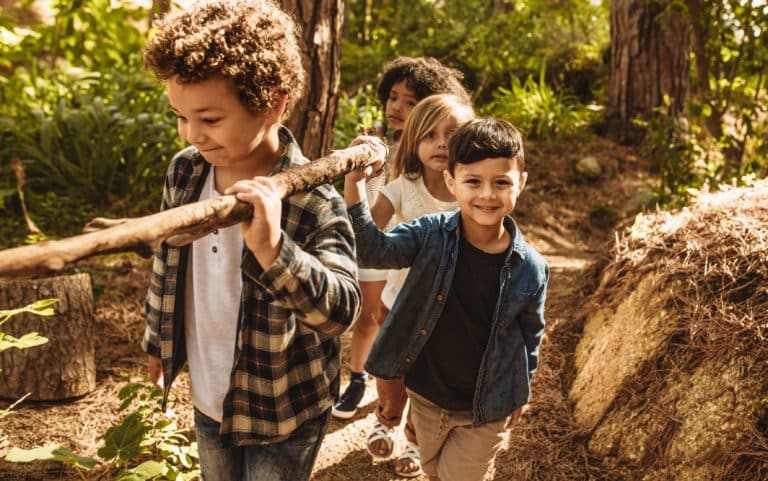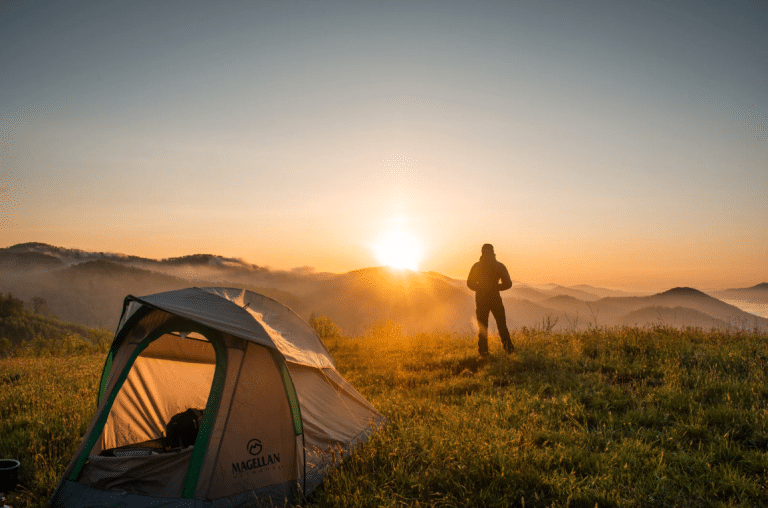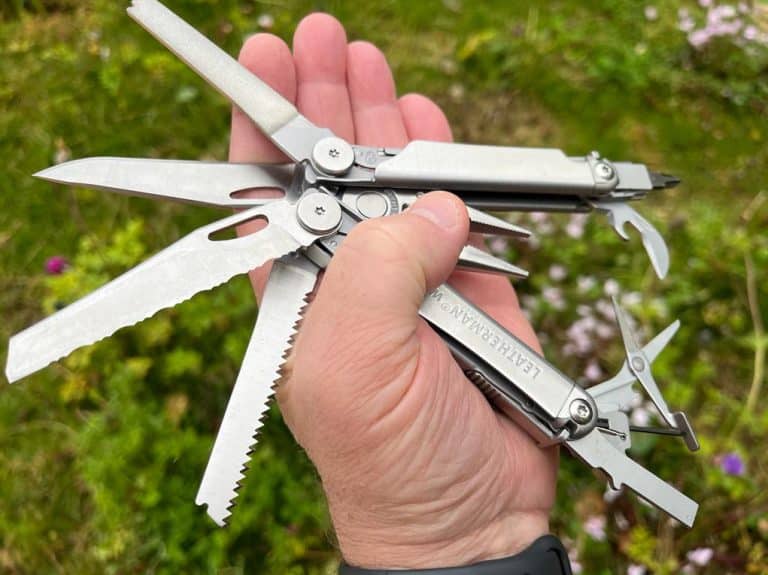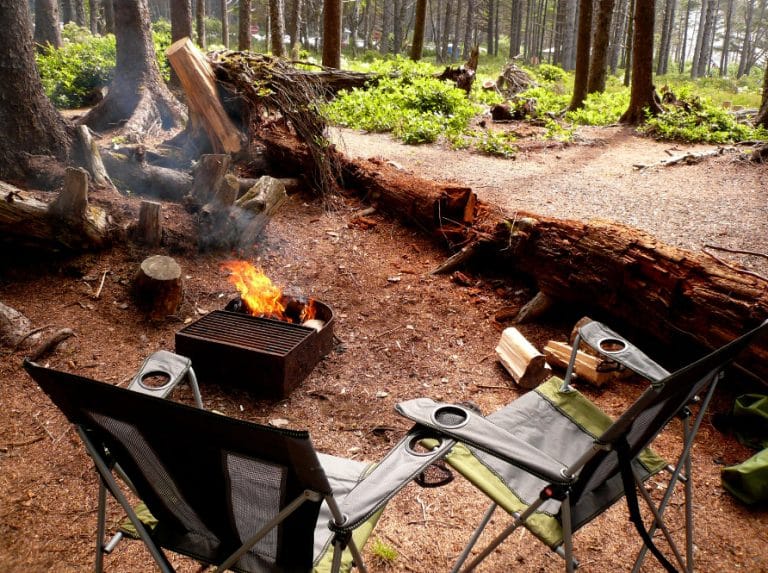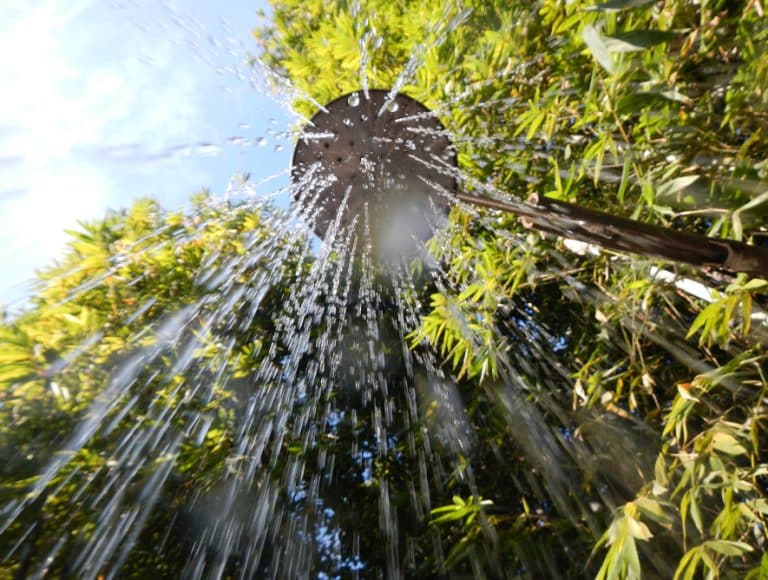Camping is a time-honored tradition that fosters a love for the great outdoors and encourages family bonding. When children are part of the mix, it’s crucial to plan activities that not only keep them engaged but also help them learn and grow. Here are some creative, entertaining, and educational camping activities to keep your kids entertained and make their camping experience unforgettable.
Nature Scavenger Hunt
A nature scavenger hunt is an excellent activity that encourages exploration and observation. Before setting out, create a list of items found in your camping environment – leaves from specific trees, a type of bird, a certain rock, etc. The goal is for the children to find as many items on the list as possible. This activity can be easily tailored to the kids’ ages and the environment you’re camping in. It’s a great way to teach children about different species of plants, animals, and insects, and it instills a sense of adventure and exploration.
Star Gazing
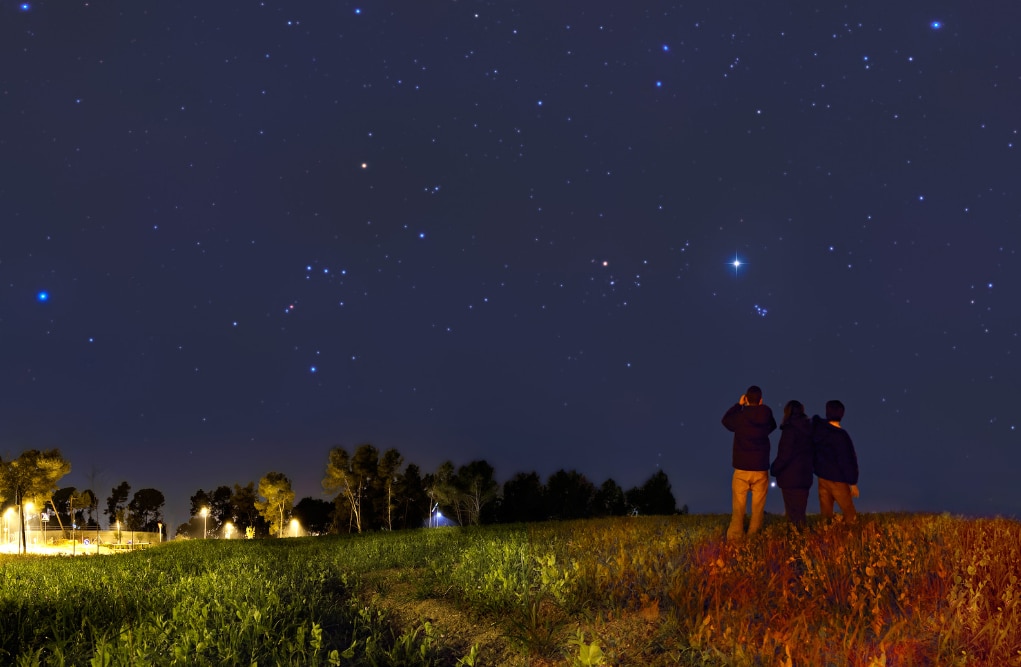
Star Gazing is a captivating activity that is perfect for camping trips, particularly those far from city lights where the night sky can be observed in all its glory. It’s an opportunity to connect with the universe beyond our planet and foster a sense of wonder in children. Here’s more about it:
- What is Star Gazing? Star gazing is the act of observing the night sky, usually with the naked eye, to appreciate and study celestial bodies such as stars, constellations, planets, the moon, and even meteor showers.
- Why is Star Gazing Important? Star gazing is not only a fun and relaxing activity, it’s also educational. It can spark interest in astronomy and other sciences, foster a sense of curiosity and wonder, and lead to a better understanding of our place in the universe. For children, it’s a chance to learn about different celestial bodies, the concept of light years, and the constellations that have fascinated humanity for thousands of years.
- How to Teach Kids About Star Gazing? Here are some tips for introducing kids to star gazing:
- Start with the Basics: Begin by pointing out the most recognizable objects in the sky, such as the moon and the planets. You can then introduce them to easy-to-spot constellations like the Big Dipper or Orion’s Belt.
- Use Tools and Apps: Consider using binoculars or a telescope to get a closer look at distant stars, the moon, or planets. There are also many stargazing apps available that can help identify stars, constellations, and other celestial bodies.
- Storytelling: The constellations have fascinating stories behind them. Telling these stories can make stargazing more engaging for kids. For example, you could share the myth of Orion the Hunter and his place in the night sky.
- Make it Interactive: Encourage your kids to draw what they see or keep a stargazing journal. This can help them remember different constellations and it’s a great way to engage their creative skills.
- Benefits of Star Gazing Star gazing can inspire a sense of wonder and curiosity in children. It encourages them to ask questions and seek answers, promoting scientific thinking. It’s also a great way for families to spend time together and create lasting memories.
Star gazing is a gateway to the universe. It’s an invitation to learn, to explore, and to dream. It’s a reminder of our connection to the cosmos and the mysteries it holds. Whether you’re pointing out the North Star or watching a meteor shower, each night brings a new opportunity for discovery.
Campfire Cooking
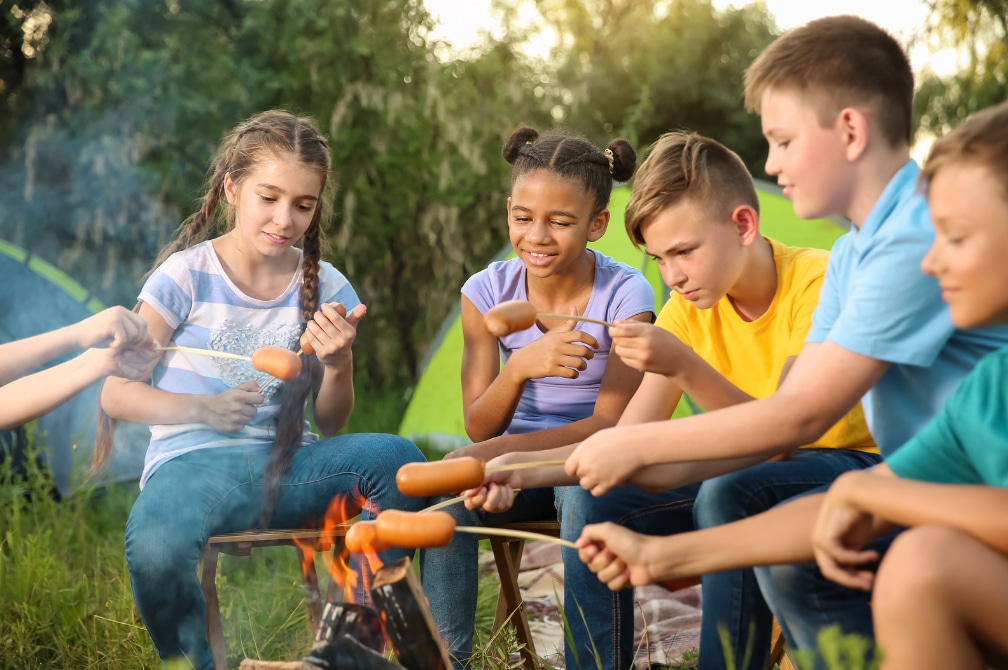
Campfire cooking is a quintessential part of the camping experience. It’s not just about the food; it’s about the process of preparing a meal in the great outdoors, the smell of the fire, the crackling of the wood, and the shared experiences around the campfire. Here’s more information about this exciting and educational activity for kids:
Safety First: Before anything else, it’s important to instill in children the importance of fire safety. They should understand that fire is not a toy and should be handled with respect and care. Kids should learn how to safely build, maintain, and extinguish a fire under adult supervision.
Cooking Equipment: Depending on the complexity of your meals, you may need various cooking utensils. Basic equipment might include a cooking grate for the campfire, pots and pans, a spatula, and skewers for roasting. Don’t forget a heat-resistant glove or pot holder!
Simple Recipes: Start with simple recipes that kids can help with. Foil packet meals are a great option. They can be prepared ahead of time, with each child choosing their own ingredients. When it’s time to cook, simply place the foil packets on the campfire coals. Other simple campfire meals include hot dogs, burgers, and marshmallows for s’mores, of course.
Learning to Cook: Children can learn fundamental cooking skills through campfire cooking. These include food preparation, controlling cooking temperatures, and timing the cooking process. They can learn about the different ways to cook over a campfire, such as grilling on a grate, roasting on a stick, or baking in a Dutch oven.
Advanced Recipes: As children become more comfortable with campfire cooking, they can try more advanced recipes. Maybe they can learn to prepare pancakes for breakfast, simmer a hearty stew for dinner, or even bake biscuits or a simple cake in a Dutch oven.
Clean-up: It’s just as important to clean up after cooking. Teach kids to clean cooking equipment properly, pack away leftovers, and ensure the fire is fully extinguished. This is also an opportunity to teach them about leaving no trace and respecting the environment.
Campfire cooking can be a fun and rewarding experience for kids, teaching them valuable life skills and giving them a sense of accomplishment. Plus, food always seems to taste better when it’s cooked over a campfire!
Hiking
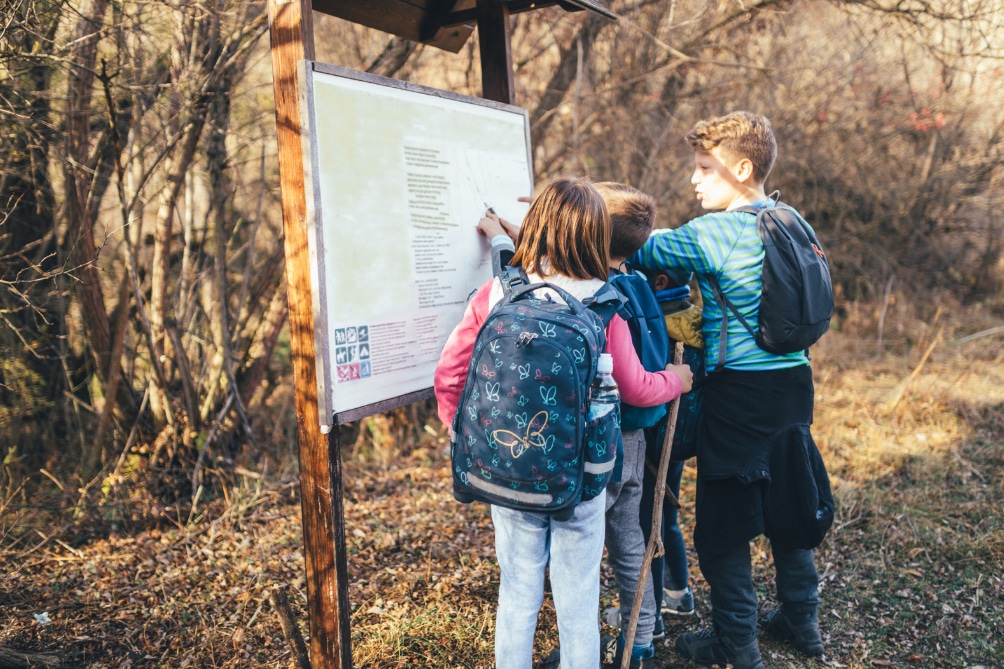
Hiking is a popular outdoor activity that provides a great way to explore nature, exercise, and bond as a group. It’s not only beneficial for physical health but can also be a rewarding learning experience for kids. Here is more information about hiking as a camping activity for kids:
- What is Hiking? Hiking involves walking through nature trails or off-beaten paths, usually in the countryside or in the mountains. It can range from easy walks on well-maintained trails to challenging treks on rugged terrain.
- Why is Hiking Beneficial for Kids? Hiking promotes physical fitness, helps improve concentration, and teaches kids about perseverance and goal setting. It’s also a great way for kids to connect with nature and learn about the local flora, fauna, and geology. Furthermore, it can foster a sense of responsibility and respect for the environment.
- How to Conduct a Hiking Activity? Here are some tips for a successful hiking activity with kids:
- Plan Ahead: Choose a trail that’s suitable for the kids’ age and fitness level. Make sure to check the weather forecast and pack essentials like water, snacks, first-aid kit, and a map or trail guide.
- Safety First: Teach kids about hiking safety, such as staying on the trail, keeping a safe distance from wildlife, and what to do if they get lost. Always supervise kids during the hike.
- Make it Educational: Turn the hike into a learning experience. Identify plants and animals, discuss geographical features, or use a compass to teach basic navigation skills.
- Keep it Fun: Plan for breaks, play games, and encourage kids to explore and express their curiosity. Remember, the goal is not just to reach the destination, but also to enjoy the journey.
- Considerations for Hiking with Kids Be patient and flexible. Kids may need more breaks and may not hike as fast as adults. Keep a positive attitude and make sure to praise their efforts to keep them motivated.
Hiking can be a wonderful way for kids to experience the beauty and wonder of the great outdoors. With the right preparation and attitude, it can become a highlight of any camping trip.
Crafts and Arts
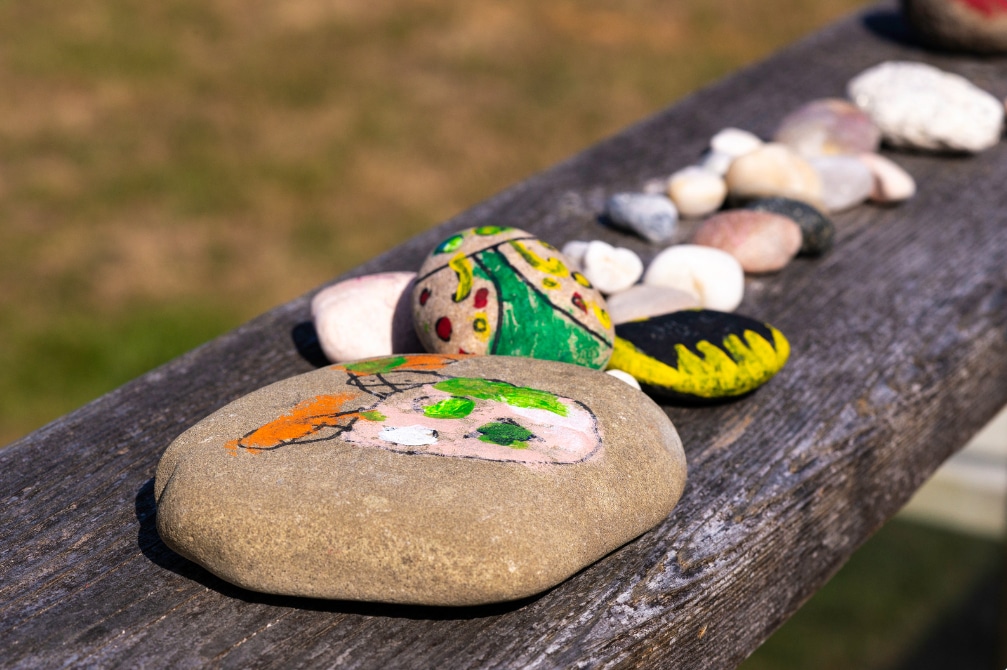
Arts and crafts are a wonderful way to stimulate creativity and imagination in kids while they’re on a camping trip. It encourages them to engage with the natural environment around them in an innovative way and also serves as a relaxing downtime activity. Here is more about incorporating arts and crafts into your camping activities for kids:
- What are Camping Arts and Crafts? Camping arts and crafts involve using materials found in nature, like leaves, twigs, pinecones, and rocks, along with some basic craft supplies, to create beautiful and unique works of art. The possibilities are endless, and the outcome is always as unique as the child creating it.
- Why are Arts and Crafts Beneficial for Kids? Arts and crafts can help kids develop fine motor skills, encourage creativity, and increase their appreciation for nature. It also provides a therapeutic outlet for expressing feelings and thoughts. The act of creating something beautiful can boost their self-confidence and provide a sense of accomplishment.
- How to Conduct Arts and Crafts Activities? Here are some ideas for arts and crafts activities:
- Nature Collage: Collect various items from nature like leaves, twigs, feathers, and flowers, and use them to make a beautiful collage on a piece of cardboard or heavy paper.
- Painted Rocks: Collect smooth rocks and paint them with acrylic paints. They can be decorated with patterns, animals, or inspirational words.
- Leaf Rubbings: Place a leaf under a piece of paper and rub a crayon over the top to reveal the intricate patterns.
- Twig Weaving: Find a Y-shaped twig and wrap yarn around it to create a loom. Weave more yarn, feathers, or other found objects into the loom to create a unique piece of art.
- Considerations for Arts and Crafts with Kids Always supervise children when they’re using scissors, glue, or other craft supplies. Make sure that they respect nature and only pick up items that have fallen on the ground. Encourage them to express their creativity freely and remind them that there’s no ‘right’ or ‘wrong’ in art.
Arts and crafts can turn any camping trip into a fun and creative adventure. It’s a great way for kids to connect with nature on a deeper level and create lasting memories.
Outdoor Games
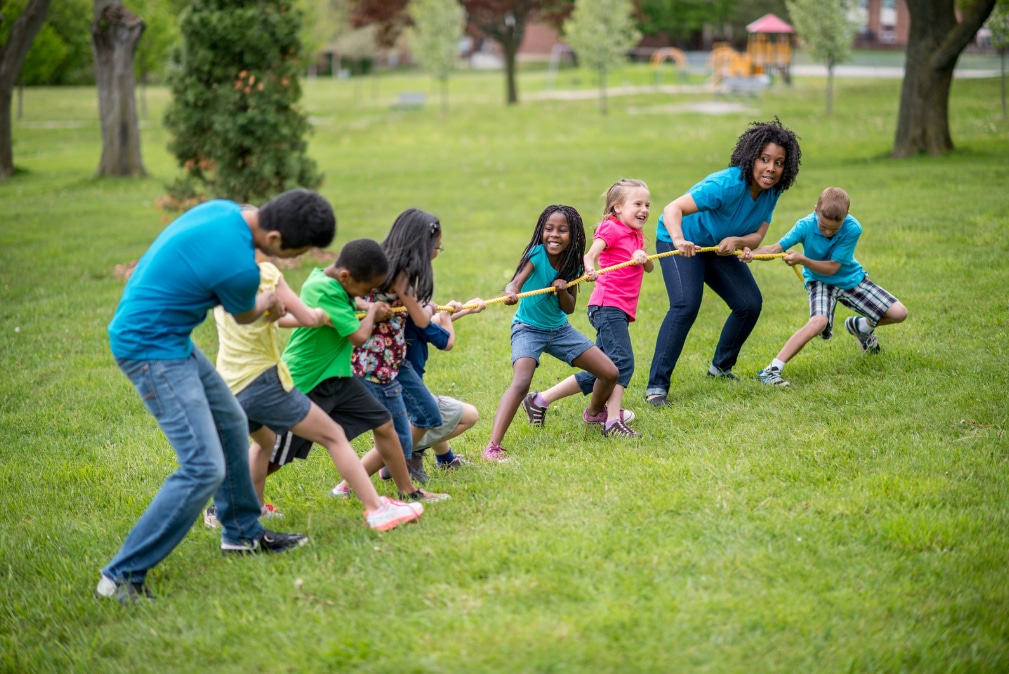
Outdoor games are a quintessential part of the camping experience for kids. They provide an opportunity for physical activity, teamwork, friendly competition, and fun, all while helping children engage with and appreciate the great outdoors. Here’s more about incorporating outdoor games into your camping activities for kids:
- What are Outdoor Games? Outdoor games are physical activities or games that are played in an outdoor setting. They can be team-based or individual, competitive or just for fun. The variety of games possible is virtually limitless and can be adapted to suit the age and abilities of the kids involved.
- Why are Outdoor Games Beneficial for Kids? Outdoor games are a great way for kids to stay active and healthy. They help develop physical skills like coordination, agility, and balance, and also promote teamwork, strategy, and sportsmanship. They also provide an opportunity to enjoy and connect with nature.
- How to Conduct Outdoor Games? Here are some ideas for outdoor games:
- Scavenger Hunt: Create a list of things to find in the surrounding nature, like a certain type of leaf, a pinecone, or a smooth rock. The first one to find all the items wins.
- Capture the Flag: Divide the kids into two teams, each with its own territory and flag. The goal is to capture the other team’s flag without being tagged.
- Nature Bingo: Create bingo cards with pictures of things to spot in nature, like a bird, a flower, or a cloud. The first one to spot all the items in a row wins.
- Tug of War: A classic game where two teams pull on opposite ends of a rope, trying to pull the other team over a line.
- Obstacle Course: Create an obstacle course using natural features like logs, rocks, and trees. The fastest one to complete the course wins.
- Considerations for Outdoor Games with Kids Safety should be the top priority when playing outdoor games. Make sure the play area is safe and free of hazards, and that the games are age-appropriate. Also, ensure the games are inclusive and fair, and that everyone gets a chance to participate and have fun.
Outdoor games can make a camping trip even more exciting and memorable for kids. They’re a great way to enjoy the beauty of nature while also having a blast.
Journaling
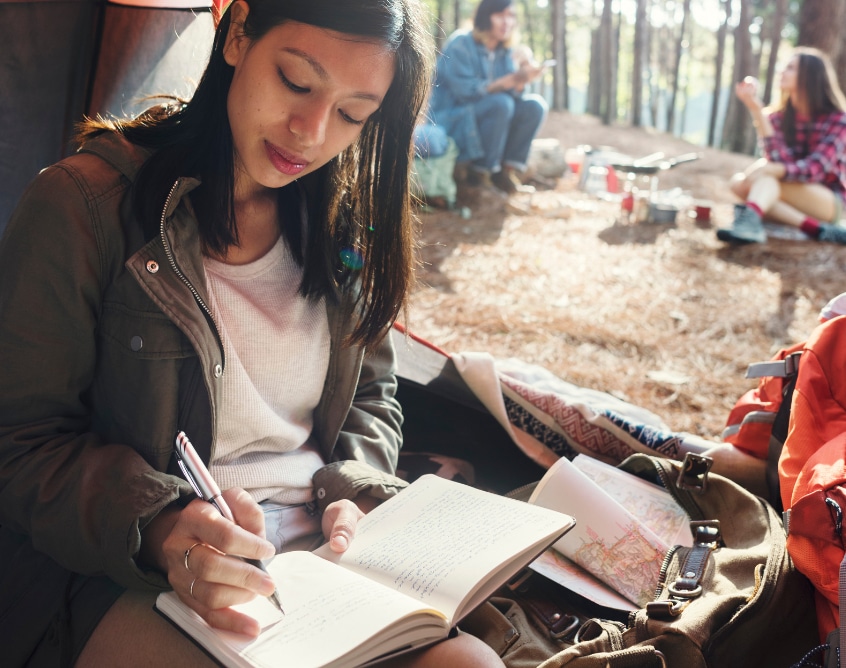
Journaling is a powerful tool for self-expression, reflection, and learning, making it a perfect activity for kids while camping. Here’s more about the benefits of journaling and how to incorporate it into your camping activities:
- What is Journaling? Journaling is the process of writing down thoughts, experiences, and observations on a regular basis. It can take many forms – from structured entries about daily activities to freeform reflections, creative stories, or sketches.
- Why is Journaling Beneficial for Kids? Journaling has numerous benefits for kids. It can:
- Improve writing and communication skills.
- Encourage self-expression and creativity.
- Enhance observational skills and attention to detail.
- Boost memory and comprehension.
- Foster mindfulness and reflection.
- Serve as a record of personal growth and experiences.
- How to Encourage Kids to Journal While Camping?
- Nature Observations: Encourage kids to write about or draw what they see, hear, and experience in nature. This could include descriptions of plants and animals, sketches of landscapes, or reflections on the beauty of the natural world.
- Daily Log: Kids can write about their activities each day, detailing what they did, who they were with, and how they felt. This can serve as a memorable keepsake of the trip.
- Creative Stories: Encourage kids to write imaginative stories inspired by their surroundings. Perhaps the rustling leaves are whispering secrets, or the local squirrels are engaged in a grand adventure.
- Gratitude Journal: Have kids write down things they’re thankful for each day. This can help them appreciate the small joys and beauty of nature.
- Considerations for Journaling with Kids
- Make sure each child has a sturdy notebook and writing utensils suitable for outdoor use. Waterproof notebooks or those with hard covers can be particularly useful.
- Encourage kids to journal, but don’t make it a chore. The goal is to foster a love of writing and observation, not to create a sense of obligation.
- Offer guidance and prompts as needed, but allow kids the freedom to use their journal in the way they find most meaningful.
Journaling while camping can be a fun, educational, and emotionally rewarding activity for kids. It not only enhances their camping experience, but also provides them with a personal memento to cherish long after the trip ends.
Bird and Wildlife Watching

Bird and wildlife watching is one of the most exciting and educational activities for kids to engage in while camping. It not only introduces them to the diverse species of animals and birds living in nature, but also teaches them to appreciate and respect wildlife. Here’s more about bird and wildlife watching as a camping activity:Bird and Wildlife Watching
- What is Bird and Wildlife Watching? Bird and wildlife watching involves observing various species of birds and animals in their natural habitat. This can be done with the naked eye or with the help of binoculars. It’s an opportunity to learn about different species, their behaviors, their habitats, and their roles in the ecosystem.
- Why is Bird and Wildlife Watching Beneficial for Kids? Bird and wildlife watching can:
- Foster an appreciation and understanding of wildlife and ecosystems.
- Improve observational skills and patience.
- Teach children about biodiversity and conservation.
- Serve as a great introduction to biology and environmental science.
- Provide a quiet, mindful activity that encourages kids to engage with nature.
- How to Encourage Kids to Engage in Bird and Wildlife Watching?
- Guided Activities: Start with guided bird or wildlife watching activities. Many campgrounds and parks offer guided tours or activities led by park rangers or naturalists.
- Identification Guides: Invest in some simple field guides or apps to help kids identify different species. Children love the challenge and reward of identifying a bird or animal they spot.
- Binoculars: Equip kids with binoculars to make the experience more engaging and exciting. There are many kid-friendly binoculars available that are sturdy and easy to use.
- Bird Feeders: If you’re in a location where it’s permitted, setting up a bird feeder can attract a variety of birds for easy viewing.
- Considerations for Bird and Wildlife Watching
- Teach kids the importance of respecting wildlife. This means observing from a distance, not disturbing animals, and never feeding wild animals.
- Explain that patience is key in wildlife watching. It may take time to spot animals or birds, but the wait makes the sighting even more rewarding.
- Use the activity as an opportunity to discuss conservation and the importance of protecting wildlife habitats.
Bird and wildlife watching is a wonderful way for kids to connect with nature while developing valuable skills and knowledge. It’s an activity that can spark a lifelong interest in wildlife and conservation.
Photography
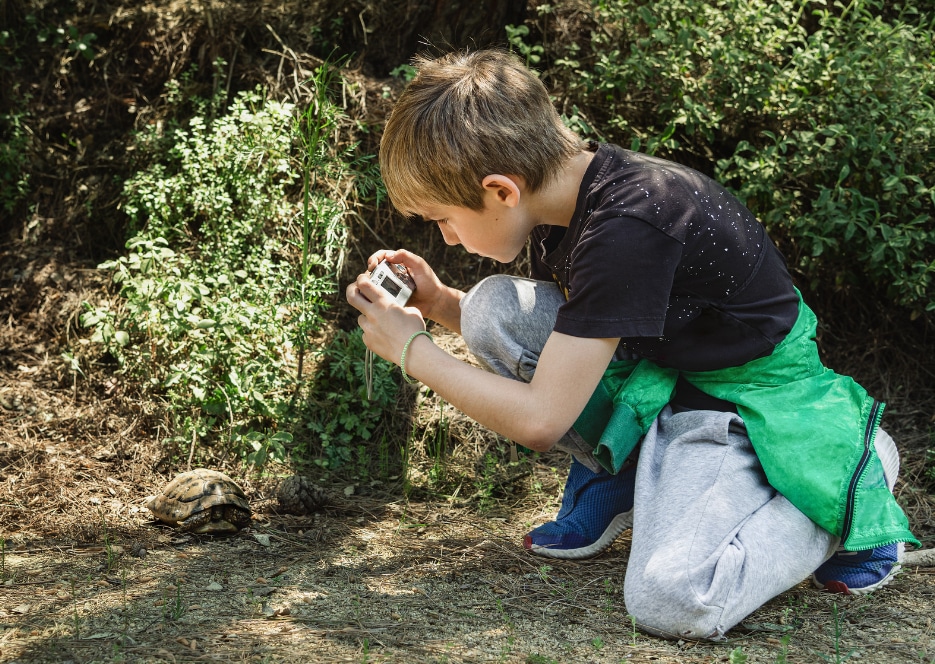
Photography can be an incredibly rewarding activity for children while camping. It’s a creative and educational pursuit that can enhance their appreciation of the natural world while also developing their technical skills and artistic sensibilities. Here’s a deeper look into this activity:
1. Equipment: While professional-grade equipment can be quite expensive, there are numerous affordable digital cameras suitable for beginners. Many smartphones also have high-quality cameras that can be used for this purpose. Waterproof and shockproof cameras might be particularly useful for outdoor activities.
2. Subjects: The natural world offers an endless array of subjects for photography. From wide landscape shots to close-ups of flowers, insects, or interesting rocks, children can learn to see the beauty in their surroundings. They can also photograph their camping activities, friends, and family to document their experiences.
3. Skills: Photography can help children develop a range of skills. On a technical level, they can learn about different camera settings such as shutter speed, aperture, and ISO, as well as the use of different lenses. On a more artistic level, they can learn about composition, lighting, and color. They can also develop their patience and observation skills, as finding the perfect shot often requires waiting for the right moment.
4. Sharing and Reviewing: After the camping trip, children can share their photos with family and friends, either in person or online. This can be a source of pride and can also provide opportunities for constructive feedback. They can also review their own photos to see their progress and to identify what worked and what didn’t in their shots.
5. Extension Activities: If children are particularly interested in photography, they can explore more advanced techniques such as macro photography, long exposure shots, or astrophotography. They can also learn about photo editing using software like Adobe Photoshop or Lightroom.
In conclusion, photography is not only a fun camping activity but also a potential lifelong hobby or even career path. By introducing children to photography during camping trips, you can provide them with a new way of engaging with and appreciating the natural world.
Tent Setting
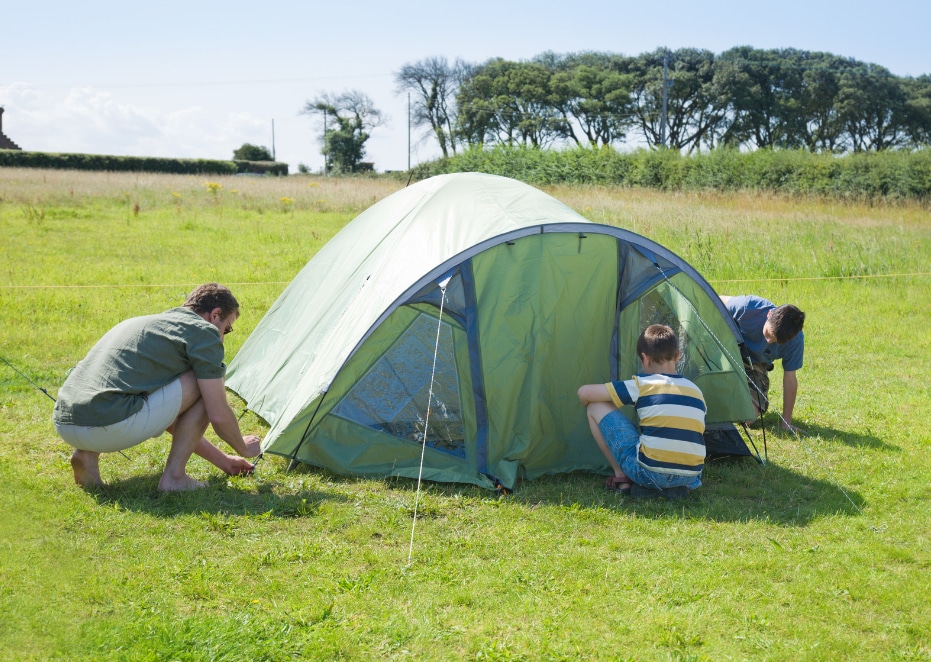
Learning how to set up a tent is an essential skill for any camper, including children. Not only does it provide a practical skill, but it also instills a sense of independence and responsibility. Here’s more information on this activity:
1. Choosing the Right Tent: It’s essential to choose a tent that is suitable for the expected weather conditions and is appropriate for the child’s age and abilities. There are tents designed for different seasons, with different capacities, and with varying levels of complexity in terms of setup. For beginners, a simple two-pole dome tent might be a good choice.
2. Selecting a Campsite: Teach children how to choose a good campsite. Look for a flat area that is free of rocks, roots, and other debris. It should be a safe distance from fire pits and water sources. Also, be sure to check above for any dangling branches that could potentially fall on the tent.
3. Tent Setup: Depending on the complexity of the tent, children may need guidance and assistance. Start by laying out the tent, assembling the poles, and inserting them into the corresponding flaps or clips. Next, raise the tent and secure it with the stakes. Finally, attach the rain fly if necessary. Remember, safety should always be the priority, so supervise children, especially when handling stakes or mallets.
4. Tent Care: Children should also be taught how to take care of the tent. This includes keeping the interior clean, avoiding wearing shoes inside, and properly storing the tent when it’s not in use. They should also learn how to handle any necessary repairs, such as patching a hole in the tent fabric.
5. Dismantling and Packing: Finally, children should learn how to properly dismantle the tent and pack it away. This involves carefully removing the poles and stakes, cleaning off any dirt or debris, and folding or rolling the tent to fit in its storage bag.
Learning to set up and care for a tent can be a fun and rewarding experience for children. It’s a chance for them to take on a significant responsibility and contribute to the camping trip in a meaningful way. This activity not only teaches practical skills but also promotes problem-solving, teamwork, and respect for one’s belongings and the environment.
Tree Identification

Tree identification is an engaging and educational activity that can be incorporated into any camping trip or outdoor adventure with children. It introduces children to botany, ecology, and the biodiversity of their surroundings. Here’s more about it:
- What is Tree Identification? Tree identification is the process of distinguishing different species of trees based on certain characteristics. This could include aspects such as the tree’s shape, size, leaf structure, bark texture, and any flowers or fruits it may have.
- Why is Tree Identification Important? Identifying trees can help children understand the diversity of plant life and how different species interact with each other and the environment. It can also foster an appreciation for nature and conservation, and instill a lifelong love for the outdoors.
- How to Teach Kids About Tree Identification? Teaching kids about tree identification can be done through a variety of methods. Here are some steps to get started:
- Start with Common Trees: Begin with common trees in your area. Start by showing them the trees and explaining the different characteristics that make the tree unique. You can use tree identification guides or apps to help.
- Discuss the Parts of a Tree: Teach kids about the parts of a tree – the roots, trunk, branches, leaves, flowers, and fruit. Explain what each part does and how it contributes to the tree’s survival.
- Use Identification Guides: Use a tree identification guide or app. These tools provide pictures and descriptions of various tree species, making it easier for kids to identify them. Encourage children to compare the tree in front of them with the images in the guide.
- Make it a Game: Turn tree identification into a game. Create a scavenger hunt where kids have to find and identify certain species of trees. This will make the learning process fun and engaging.
- Benefits of Tree Identification Besides fostering an appreciation for nature, tree identification can improve observation skills, promote problem-solving, and encourage scientific thinking. It can also lead to broader conversations about ecosystems, the importance of trees in the environment, and the role of conservation in preserving biodiversity.
Remember, the goal is not just to identify as many trees as possible, but to engage children’s curiosity and get them interested in learning more about the natural world. Whether they’re identifying a mighty oak or a humble pine, every new tree is an opportunity for discovery.
Building Mini Rafts

Building mini rafts is a fun, engaging, and educational activity that can be integrated into any camping trip with kids. It not only stimulates creativity and critical thinking, but also provides an opportunity to learn about the principles of buoyancy, engineering, and navigation. Below, I will provide more information about this activity:
- What is Mini Raft Building? Mini raft building involves constructing small, floatable rafts using natural materials commonly found in a camping environment, such as sticks, leaves, bark, or small pieces of driftwood. Once built, these rafts can be tested in a nearby stream, river, or lake to see if they float.
- Why is Mini Raft Building Beneficial for Kids? This activity is beneficial for kids because it combines creativity, problem-solving, and practical skills. It encourages children to think about design and construction, and how different materials and shapes can affect a raft’s buoyancy and stability. It’s also a great way to introduce basic principles of physics and engineering in a fun, hands-on way.
- How to Build a Mini Raft? Here’s a simple guide to building a mini raft:
- Gather Materials: Begin by collecting sticks of similar length. You’ll also need a flat piece of bark or leaf for the base, and some twigs or reeds to bind the raft together.
- Construct the Base: Lay the sticks side by side to form the base of the raft. The width and length of the raft will depend on the size of your sticks.
- Bind the Sticks: Use the twigs or reeds to bind the sticks together. You can do this by weaving them in and out of the sticks, or by tying them around the ends.
- Add a Sail: For an added touch, make a sail out of a leaf or piece of bark and attach it to the raft.
- Test Your Raft: Once the raft is built, test it in the water to see if it floats.
- Safety Considerations Always supervise children around water, and ensure they are aware of water safety rules. Also, remind them to respect the environment and not to damage living trees or plants when gathering materials.
Building mini rafts is a memorable and educational activity that can spark children’s interest in science and nature. It’s a wonderful way to make the most out of a camping trip, and children will delight in seeing their handmade rafts float down a stream or across a pond.
Campfire Storytelling
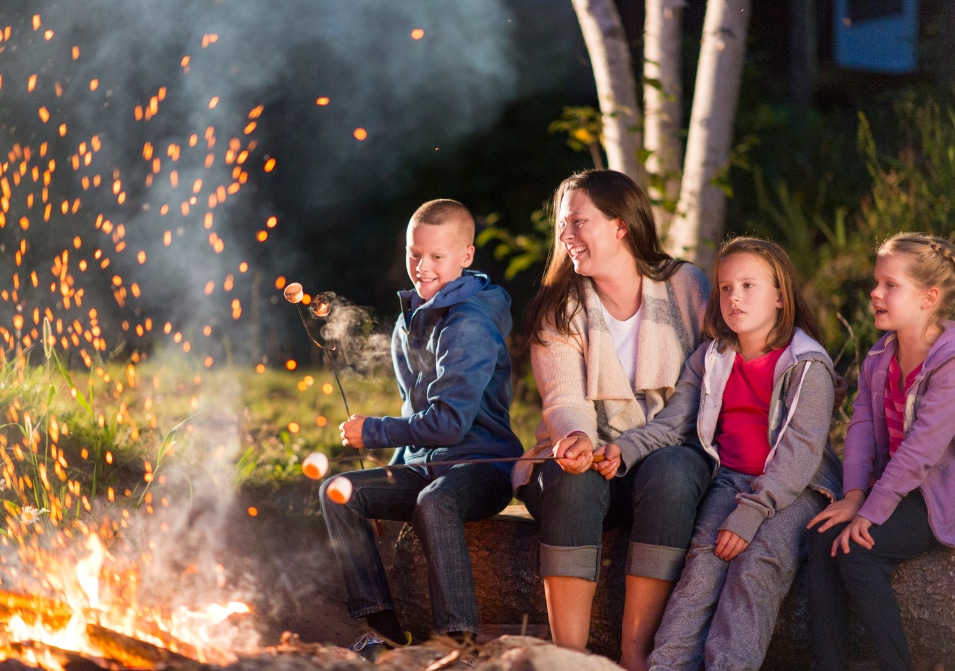
Campfire storytelling is a time-honored tradition that dates back to the earliest days of human civilization. It’s an activity that not only entertains but also brings people together and fosters a sense of community. Here is more information about this classic camping activity for kids:
- What is Campfire Storytelling? Campfire storytelling involves sharing stories around a campfire. The stories can be fictional or true, funny or scary, traditional or improvised. The flickering light of the campfire and the darkness of the surrounding night create a perfect atmosphere for storytelling, making the tales seem more vivid and engaging.
- Why is Campfire Storytelling Beneficial for Kids? Campfire storytelling encourages imagination, creativity, and language skills. Kids can practice their listening skills, learn about plot structure and character development, and even start to create their own stories. It can also be a great way to teach children about different cultures and traditions, as many stories have been passed down through generations and across cultural lines.
- How to Conduct Campfire Storytelling? Here are some tips for effective campfire storytelling:
- Choose Appropriate Stories: Depending on the age of the children, choose stories that are suitable for their understanding and interest level. For younger children, short, simple, and colorful stories work best. Older kids might enjoy more complex narratives or spooky tales.
- Use Dramatic Effects: Use different voices for different characters, vary your tone and pace, and don’t be afraid to use gestures or facial expressions to bring the story to life.
- Encourage Participation: You can make the storytelling interactive by encouraging the children to predict what will happen next, ask questions, or even act out parts of the story.
- Create Your Own Stories: Encourage kids to create their own stories. This can be a fun exercise in creativity and can also boost their confidence.
- Safety Considerations As with any activity involving a fire, safety is paramount. Ensure the campfire is contained and controlled, and never leave it unattended. Teach children to respect the fire and keep a safe distance.
Campfire storytelling is a magical and enriching camping activity. Whether the stories told are filled with adventure, mystery, humor, or wisdom, they will create lasting memories and provide valuable learning experiences for kids.
Learning Survival Skills
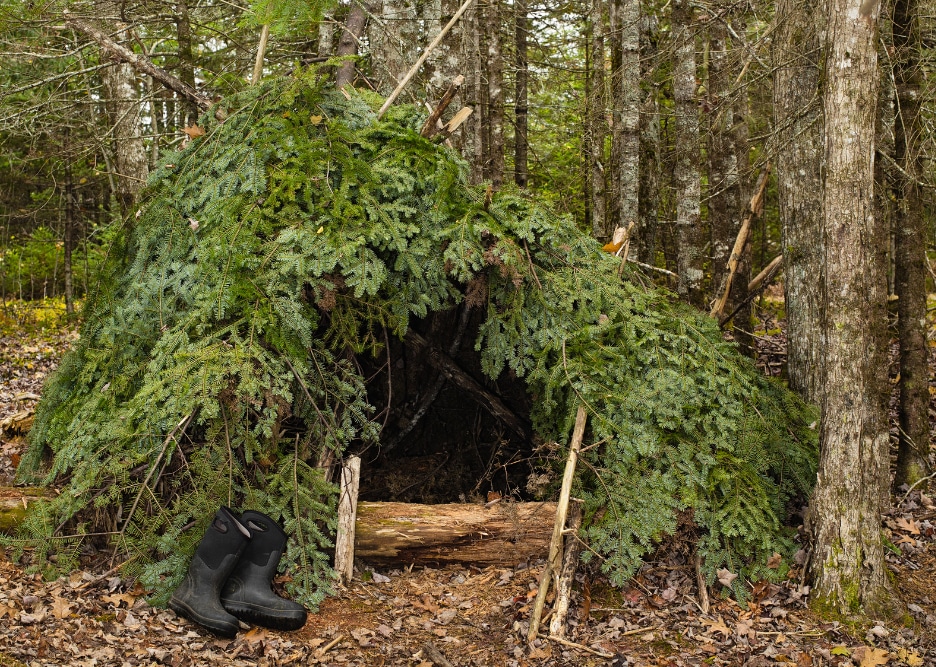
Learning survival skills is an essential part of any camping trip and is particularly beneficial for children. It not only makes them self-reliant but also builds confidence and resilience. These skills can be life-saving in certain situations and are also a great way to instill a love and respect for nature. Here’s more about it:
- What are Survival Skills? Survival skills are techniques a person may use in order to sustain life in any type of natural environment or built environment. These techniques are meant to provide basic necessities for human life: water, food, shelter, habitat, the ability to think straight, to signal for help, to navigate safely, to avoid unpleasant interactions with animals and plants, and to cure any incurred injury or illnesses.
- Why are Survival Skills Important? Survival skills are crucial because they can save your life in an emergency. They are also a way to teach kids about self-reliance and problem-solving. By learning these skills, kids can gain a greater appreciation for the outdoors and learn to respect nature.
- How to Teach Kids About Survival Skills? Here are some ways to introduce kids to survival skills:
- Build a Shelter: Teach them how to build a shelter using natural materials. This can be as simple as a lean-to or a more complex structure like a debris hut.
- Start a Fire: Show them how to safely start and extinguish a fire. Discuss the importance of fire safety and the role of fire in survival situations.
- Find Water: Discuss the importance of clean water and teach them different methods of water purification.
- Learn Navigation: Introduce them to basic navigation skills using a compass and the stars.
- First Aid Skills: Teach them basic first aid skills, like how to treat cuts and burns or what to do if someone gets a sprain.
- Recognize Edible Plants: If it’s safe and legal in your area, you can teach kids about foraging and how to identify safe, edible plants and berries.
- Leave No Trace: Above all, teach them the principle of “Leave No Trace” – respecting nature by leaving the environment as you found it.
- Benefits of Learning Survival Skills By learning survival skills, children can become more confident and self-reliant. These skills can also help develop problem-solving abilities, teamwork, and leadership skills. Plus, it can increase their respect for nature and the environment.
Learning survival skills doesn’t just equip kids with the knowledge to handle difficult situations – it also provides a unique, hands-on way to learn about science, geography, and ecology. It encourages them to think critically, make decisions, and take responsibility, which are valuable skills in all areas of life.
Final Thoughts
Camping trips offer a unique opportunity for children to learn, grow, and create lasting memories. These camping activity ideas are designed to keep kids engaged, encourage learning, and foster a deep appreciation for nature. Remember, the primary goal is to ensure that the kids have fun while also gaining new skills and experiences. Each camping trip is a new adventure, and with these activities, your kids will be eagerly anticipating each one. Happy camping!
